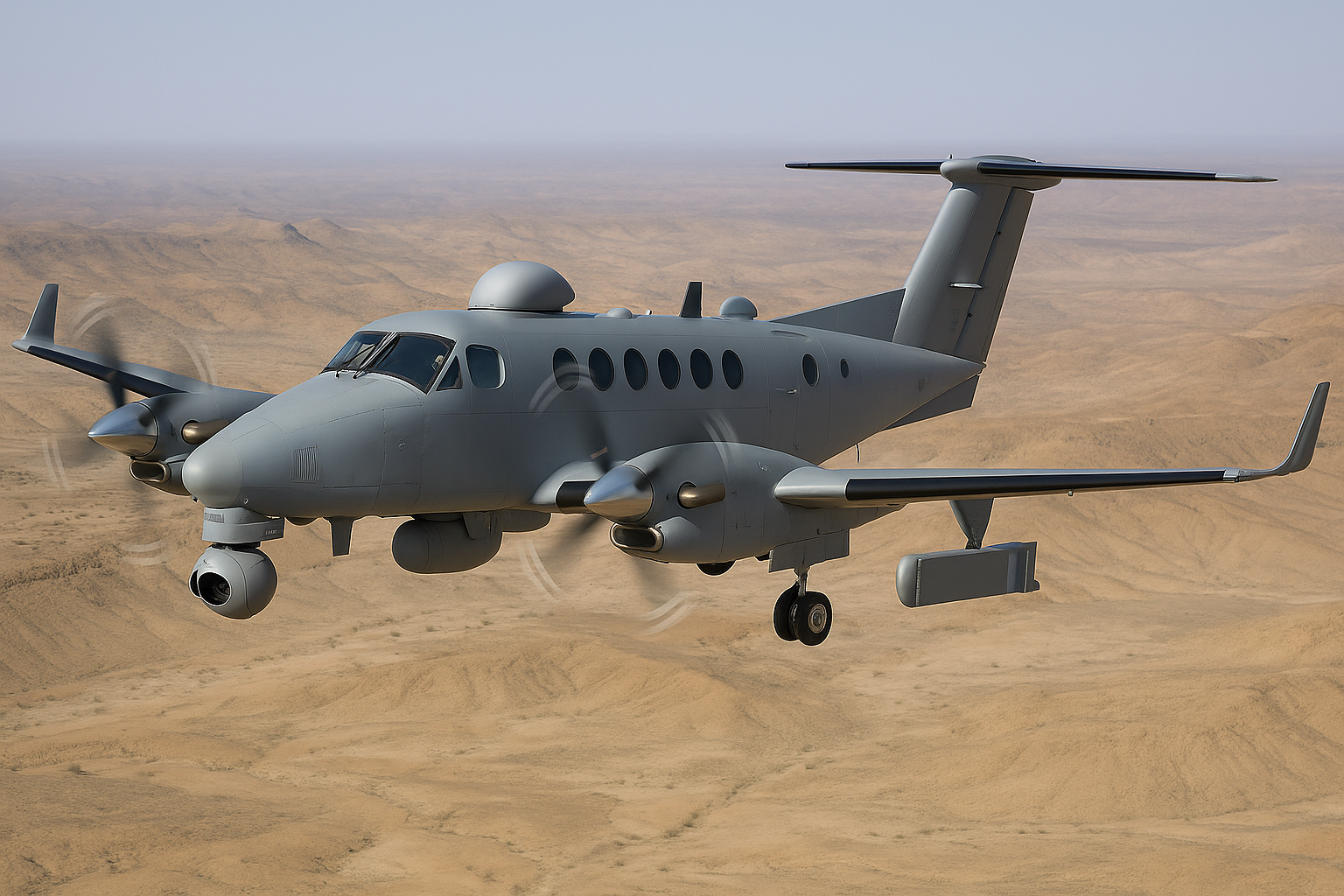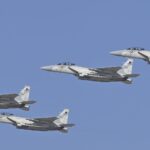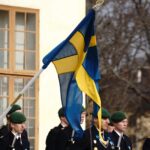L-3 Communications, Platform Integration Division, Waco, Texas, received a not-to-exceed $41.5 million undefinitized contract action to supply four intelligence, surveillance, and reconnaissance (ISR) aircraft, spares, and crew training to support counter-terrorism operations in Yemen. The contract number is FA8620-14-C-3020. Big Safari—officially the 645th Aeronautical Systems Group at Wright-Patterson Air Force Base, Ohio—serves as contracting authority. Completion is set for September 30, 2015, under 100 percent Foreign Military Sales funding for Yemen. This contract reflects broader efforts to strengthen U.S. military capability through targeted foreign partnerships.
ISR Aircraft Delivery for Yemen Under Pentagon Contract
The package covers fully modified Beech King Air 350 airframes. L-3 will strip factory interiors, cut new apertures, and hard-mount sensors that let a two-person crew collect imagery and signals in a single pass.
Key hardware:
• A multi-spectral turret with electro-optical and infrared channels.
• A wide-area radar able to track small vehicles on desert roads.
• An onboard data link that beams raw feeds straight to ground stations.
• A roll-on mission console with high-speed processors and solid-state recorders.
Each airframe leaves Waco with factory-new Pratt & Whitney PT6A-60A engines, Kevlar fuel-tank liners, and removable armor under the cockpit floor. The mission fits underscore L-3’s counterterrorism ISR role in Yemen, which gained momentum after a wave of bombings in 2012. The King Air’s pressurized cabin gives crews eight hours on station without refuel stops, a vital edge for long border runs along Yemen’s interior.
Yemen asked for a turnkey solution after a 2012 wave of insurgent bombings proved that its existing Antonov transports and Mil-8 helicopters lacked the reach to track small militant convoys. A classified State Department cable in late 2013 cleared the purchase. Within 90 days, Big Safari issued a sole-source letter citing “compelling urgency.” The undefinitized clause lets work start at once; pricing is fixed only after design reviews close.
Under the plan:
- L-3 keeps one aircraft in Texas as an engineering test bed until July 2015.
- Three others fly directly to Yemen’s al-Sayyoun air base on staggered ferries.
- A six-week training block in San Angelo, Texas, teaches Yemeni pilots IFR skills.
- A second, shorter course in-country focuses on sensor operation and simple airframe maintenance.
Logistics follow U.S. Special Operations Command templates. Mobile parts kits travel with the aircraft. A U.S. field service rep stays at al-Sayyoun for nine months, then hands support to Yemeni depot staff.
The move is Yemen’s first major ISR buy since 2009. It arrives in a region where surveillance gaps still hamper coalition strikes. Pentagon planners chose the King Air in part because the platform needs no heavy runway equipment. Aluminum matting can create temporary strips within hours.
Defense analysts see the award as small in dollar value yet large in influence. L-3’s SPYDR upgrade set, proven in Afghanistan, draws praise for low life-cycle cost: no pressurization mods, no exotic composites. By holding procurement costs under $11 million per aircraft—including spares—Big Safari avoided long congressional debate.
Risk remains. The Yemeni Air Force lacks depth in avionics maintenance. To cut downtime, L-3 will pre-wire each tail for quick-swap line-replaceable units. The Air Force Security Assistance Center also earmarked funds for three years of emergency depot work in Texas if structural repairs exceed local capacity.
An L-3 vice president, speaking on background, called the timeline “aggressive but achievable.” He noted that Big Safari previously fielded King Air quick-reaction kits in less than 12 months for Iraq’s Task Force Observe.
While contract paperwork lists “four ISR aircraft,” Pentagon sources say the payload mirrors the firm’s commercial SPYDR system. The sensor bay carries both daytime and mid-wave cameras on a pneumatic hoist. Engineers route heat exhaust into the wings to avoid hot spots that would betray the aircraft to shoulder-fired missiles.
The deal strengthens a supply chain spread across five states. Waco handles major fuselage work. Sensor gimbals ship from Wilsonville, Oregon. Secure radios come from Garland, Texas. Such projects complement regional airpower efforts like Egypt’s F-16 procurement, reinforcing allied ISR and strike capabilities. Assembly planners map each line item onto an Earned Value chart that must stay within three percent variance to meet September 2015 delivery.
Big Safari typically works under tight secrecy, yet the office confirmed the Yemen sale in a two-sentence release. Officials did so to satisfy foreign-military-sales disclosure rules. Yemen continues to battle al-Qaeda in the Arabian Peninsula (AQAP). The ISR package gives its forces an immediate eye in the sky without drones, whose export faces stricter State Department controls.
A Pentagon budget officer said the office chose a fixed-wing solution because operating costs run about $1,200 per flight hour—far below those for a medium-altitude drone once full logistics are counted. Yemen also gains sovereign control of collected data, avoiding political friction that sometimes follows U.S.-run surveillance.
L3Harris News – ISR Aircraft Influence in Yemen and Jordan
Contract language notes a “not-to-exceed” ceiling. Final price hinges on components selected after flight tests. If the Yemeni customer requests extra radios or different ground stations, Big Safari can adjust via engineering change proposals. Funding for such changes must move fast, yet senior Air Force buyers insist the package will stay under the congressional notification threshold that triggers a thirty-day hold.
L-3’s Waco plant already holds a parts stock for earlier King Air work. Managers plan double-shift coverage, yet they say the yard can take in outside commercial work without delaying the four tail numbers for Yemen.
A soft landing at al-Sayyoun ends delivery, but the bigger challenge starts then: merging new data flows with an intelligence branch that mainly relies on human reporting. Defense Cooperation officials wrote an annex on secure room construction, including redundant power and grounded racks, so video feeds stay clean in a region plagued by brownouts.
The Pentagon expects minimal risk in obtaining export clearances. All sensors carry ITAR approval for Tier-2 partners. A cryptographic key-loader stays under U.S. custodial control until Yemen issues user certificates, a step that ensures the hardware cannot be cloned if insurgents seize an aircraft.
Observers in Congress marked the contract for later audit because undefinitized actions sometimes inflate costs. Big Safari counters that its rapid-field model cuts life loss during emerging threats. Yemen’s interior ministry agrees, citing a 2013 raid where insurgents slipped across open desert.
ISR aircraft alone never end insurgencies. Still, the deal lets Yemen map convoy routes and pass targeting data to fixed-wing strike fighters. Voices at U.S. Central Command say the buy starts a longer plan to build a small regional ISR fleet that neighbors can copy.
L-3 stands to gain follow-on work if Yemen orders more airframes. King Air production lines run hot in Wichita; airframes can roll from factory to Waco in weeks.
Editor’s note: Sources at Big Safari rarely name platforms, yet sensor fits on previous contracts suggest the aircraft will fly under the SPYDR banner. Years of overseas deployments proved the kit’s rugged recorders can run despite dust, high humidity, and abrupt power spikes—conditions similar to Yemen’s central plateau.
Jordan Receives ISR Aircraft Under Pentagon Contracts – JUNE 2025 UPDATE
March 2025 brings fresh context. The original date atop this dispatch remains June 02, 2014, yet events over the past decade reshape the picture.
Combat inside Yemen spiraled far beyond expectations. After the Houthi advance on Sana’a in 2015, U.S. advisors withdrew. Big Safari, facing rising risk, used an Air Force letter of direction to halt shipments. The four King Air 350s never reached al-Sayyoun. Instead, workers at Waco pressed on with modifications while Washington searched for a safer end user.
By autumn 2015, Jordan emerged as that customer. A new justification‐and-approval memo cited “urgent border security needs.” Crews ferried the first airframe into Marka Air Base on November 3 that year. Within six months, the other three tails arrived, creating Jordan’s first fixed-wing ISR squadron. This rollout exemplified the Pentagon’s rapid ISR deployment to Jordan, in response to growing regional threats. Local pilots, trained in Texas, logged 1,100 flight hours during 2016 trans-desert patrols along the Iraqi and Syrian frontiers. Royal Jordanian Air Force officers credit the aircraft with spotting more than 340 illicit crossings before ground troops intercepted smugglers.
L3Harris ISR Aircraft Contracts with Jordan – Pentagon Oversight and Modernization
L-3’s corporate shape also changed. A 2019 all-stock merger with Harris Corporation created L3Harris Technologies. The deal folded Waco’s Platform Integration plant into the new Integrated Systems segment. Management kept the King Air line running, branding the update set under the ISR Sky Warden family.
Follow-on sustainment now dominates spending. A December 13, 2024 task order, FA8620-25-F-B023, funds Jordan fleet support through 2027. It covers engine overhauls, spare propeller hubs, and mid-life avionics refresh. Big Safari remains contract owner, still operating from Wright-Patterson under its legacy WIJK office symbol.
Industry praise surrounds the serial, low-visibility approach. Jordan, a long-time F-16 operator, found the King Air’s fuel burn attractive. Flying the twin-turboprop costs barely one-eighth the hourly rate of a single Viper yet delivers better motion-video quality for convoy scouting.
Not all headlines glow. On May 22, 2025, the U.S. Justice Department announced that L3Harris agreed to pay a $62 million settlement after auditors uncovered historical pricing errors across multiple contracts between 2006 and 2014. The firm admitted no liability, but the fine drew Congressional oversight attention. Air Force contracting officers reviewed open L3Harris orders; none have paused to date, and Big Safari’s Jordan sustainment work continues on schedule.
Technically, the fleet evolved. Jordan swapped the original turret choice for a lighter-weight MX-15 sensor, freeing seventy kilograms for a tactical radio stack that streams live video to armored patrols. Engineers added a protective filter to the data-link antenna to cut desert sand intrusion—an upgrade now baked into every depot visit.
Milestones since 2014:
- November 2015—first delivery to Jordan.
- March 2017—full operational capability reached after software baseline 2.0 load.
- July 2019—merger forms L3Harris; Waco plant re-aligns under Integrated Systems.
- October 2023—Jordan logs 10,000th flight hour across the fleet.
- December 2024—new sustainment task order secured through 2027.
- May 2025—L3Harris reaches federal settlement over historical pricing data.
Jordan aims to keep the quartet flying past 2032. Talks with L3Harris cover a glass-cockpit refresh that will add synthetic-vision displays, easing crew workload on night border sweeps. Big Safari signals support, calling the aircraft “a textbook study in small-footprint ISR.”
For Yemen, the story is less upbeat. Civil war rages. The 2014 purchase remains on FMS ledgers as a completed case, yet no tail ever landed under Yemeni markings. Quietly, the Pentagon wrote off the country’s original training funds when conflict shut the airspace.
Looking ahead, L3Harris markets the King Air-based suite as a low-risk add-on for nations with tight defense budgets. The Jordan experience, built on the contract first signed in June 2014, supplies the sales pitch: low cost, flexible routing, and rapid delivery once politics line up.
The four durable twins still fly daily from Marka. Crews launch near dawn, hug thin flight levels below jet traffic, and scan desert roads with gimbaled optics that trace their provenance to the old SPYDR line. One decade on, a small Pentagon press note still underpins real-world patrols that show no sign of slowing.
REFERENCE SOURCES
- https://www.defensedaily.com/l3harris-to-pay-62-million-fine-to-settle-allegations-over-false-pricing/business-financial/
- https://www.afcea.org/signal-media/l-3-support-counterterrorism-isr-yemen
- https://news.clearancejobs.com/2014/06/02/lockheed-martin-awarded-space-fence-contract-dod-daily-contracts/
- https://medium.com/war-is-boring/the-pentagon-rushes-tiny-spy-planes-to-jordan-4034428803e9
- https://armyrecognition.com/news/aerospace-news/2015/us-plans-to-deliver-four-isr-planes-to-jordan-for-border-surveillance-missions
- http://investors.l3harris.com/news/news-details/2019/L3Harris-Technologies-Merger-Successfully-Completed-Board-of-Directors-Leadership-and-Organization-Structure-Announced-07-01-2019/default.aspx
- https://www.defense.gov/News/Contracts/Contract/Article/4001063/
- https://www.sltrib.com/news/business/2025/05/25/l3harris-technologies-pay-62m/
- https://spacecoastdefense.substack.com/p/l3harris-faces-62m-federal-settlement



